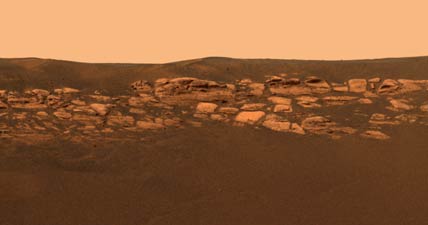
The red arid terrain seen at the Opportunity landing site appears to have once been a locale capable of sustaining life.
Courtesy NASA/JPL/Cornell.
When the two Mars Exploration Rover missions were first envisioned, their mission was clear: find if and where water once persisted on Mars. To do this, Spirit landed in a putative ancient Martian lake; Opportunity landed on a plain known to contain crystalline hematite — a mineralogical sign suggesting water. Today NASA scientists announced that Opportunity's mission is a success. The rocks below its wheels were once "soaked with liquid water," said Steven W. Squyres (Cornell University). Moreover, the now-desiccated terrain was once a location that could have supported life. "This was once a habitable environment for some amount of time," Squyres said.
Four pieces of evidence led the scientists to their conclusion:
While this evidence doesn't come as a surprise to many in the field — planetary geologists have suspected for decades that water must have flowed abundantly on the Martian surface — it is the kind of proof they sought. However, astronomers can't yet determine when the water was there, or for how long it remained.
The high abundance of salts, at some places equaling 40 percent of the exposed outcrop region, point strongly to an evaporation sequence, said Benton C. Clark III (Lockheed Martin Space Systems). The salts first dissolved in water, and then as the briny liquid evaporated away, it left behind the minerals Opportunity finds today. Based on the concentrations of salt measured, before it disappeared the water was "easily as salty as the Dead Sea" said Clark.
"Liquid water once flowed through these rocks," said Squyres. "It changed their texture, and it changed their chemistry." The next step is to determine when and how.
 0
0
Comments
You must be logged in to post a comment.